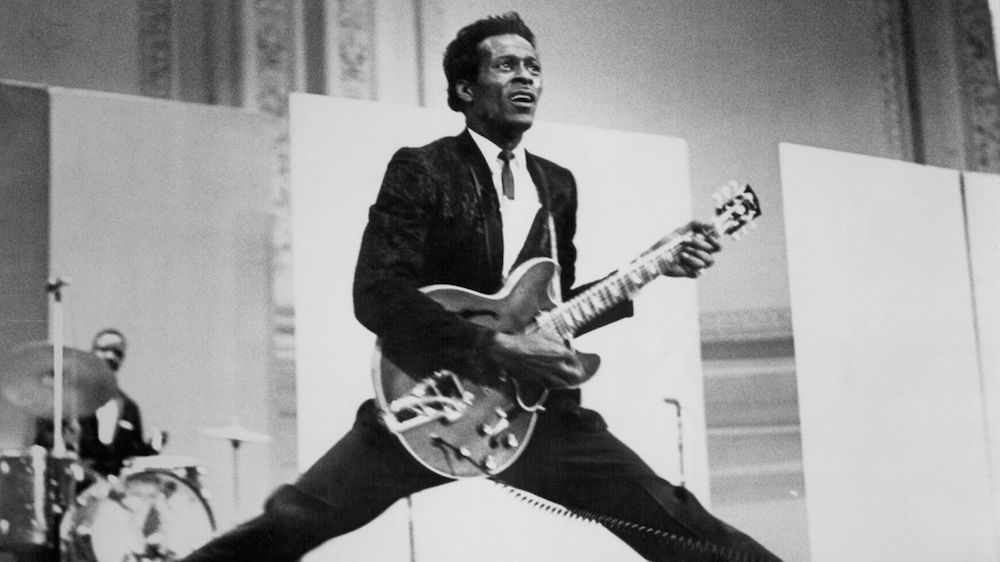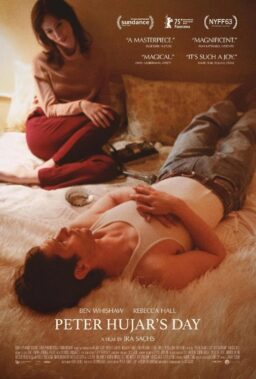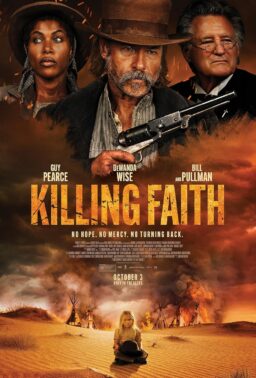Chuck Berry, who died this weekend at the age of 90, was a great many things, but one thing he was not was an actor. His minimalist line readings, when he had lines, in mid-fifties films like “Rock, Rock, Rock,” “Mister Rock and Roll,” and “Go Johnny Go” were perhaps even less than one would expect. And yet. If you ever want to see a movie performer burn a hole in the screen with just his eyes, take a look at the 1987 documentary “Hail! Hail! Rock ‘N’ Roll,” directed by Taylor Hackford to commemorate Chuck’s birthday. And watch the way the father of rock and roll glares at Keith Richards at, more or less, the suggestion that he needs to rehearse. The man could be scary.
The early obits of the St. Louis native call him a guitar innovator, which he was, but there was so much more to Chuck Berry than that. He synthesized an entire sensibility and also wrote some of the greatest American short-stories-in-song that have ever been sung. On Twitter, the critic Jody Rosen wrote of “Johnny B. Goode”: “Try to find a better American story, more pithily told.” “There stood a log cabin made of earth and wood/Where lived a country boy named Johnny B. Goode/Who never ever learned to read or write so well/but he could play a guitar just like a ringing a bell.” Anybody can say of someone, “He never learned to read or write.” A genius says “never ever learned to read or write so well.”
The Internet Movie Database lists over a hundred soundtrack credits for Berry. That sounds low to me. Every movie that has a rock and roll song in it owes Chuck Berry. Even though pop culture is into its second decade in which rock is no longer the dominant form of popular music, Chuck Berry remains a signifier of so very much. And his music still gives great pleasure.
Berry was not a teen prodigy. He was a working man—yeah, the guy who wrote so much about cars did time on an auto assembly line, and did shifts as a janitor too—who made music on the side and honed his craft until he was almost 30, when he took the trip from St. Louis to Chicago on the advice of bluesman Muddy Waters. He made his greatest records for Chess, a label with which he had as fraught a relationship as any of its other artists (one of whom was Waters). His songs were built on a succession of solid riffs, chords syncopated in a variation of a boogie-woogie piano pattern, played on a nicely treble-heavy hollow body electric guitar (usually a Gibson ES-350 or 355), followed by a lyric, perfect in meter and rhyme, sung in a bright, friendly tenor, telling tales of uncooperative cars, boring days in school, nervousness at the local dance, the joys of American cities and American foods. “I’m so glad I’m living in the U.S.A.,” he sang, completely without irony. And when the radical MC5 covered Chuck’s song, they weren’t kidding either. When John Travolta and Uma Thurman dance to Chuck’s “You Never Can Tell” in “Pulp Fiction” it’s not just a celebration of nostalgic pop culture. It’s a celebration of this country.
Everybody who picks up an electric guitar will always owe a debt to Chuck Berry, and I reckon that includes jazz guitarists too. Some do not quite honor that debt. In the 1970s, the critic Robert Christgau bristled at the wet-noodle duo Loggins and Messina presuming to call one of their limp tunes a tribute to Chuck. “The nerve,” wrote Christgau. “Chuck Berry had genius, energy, soul, spunk, wit, irreverence, brains, urgency, a good beat, a criminal record, a number-one record, brown skin, a pompadour, and a duckwalk. All they’ve got is a million dollars—or less, I hope.”
Which brings us to the most famous use of Chuck Berry’s work in all of cinema. You know what I’m talking about. When Marty McFly “invents” the “Johnny B. Goode” riff and patented Berry duckwalk in “Back to the Future.” Is this a tribute, or the most sick-making episode of what we now call “whitewashing” in the history of pop culture? The more you know about what Chuck Berry went through in his life and career, the more you might be inclined to think of it as the latter. “He came out of prison with a chip on his shoulder,” Richards notes in “Hail! Hail!” not with any sense of grievance but with a slight sense of mourning. Berry was arrested in 1959 on a violation of the Mann Act, the specifics of the charge having to do with interstate transit of a minor for the purposes of sexual intercourse. Berry claimed he was a target of racism, and as reckless as a lot of male performers in this music acted then and now, there’s little doubt that he was someone that the establishment wanted to take down. His success was a vindication of the idea of the American Dream. His imprisonment was arguably a result of the power of institutional racism. “Livin’ In The U.S.A.” acknowledges that the country gave Chuck so much. But then the country took away his freedom. And now a movie wants to use a clever time-travel plot twist to have a white teenager from the future give Chuck Berry the idea for “Johnny B. Goode?” I can see the problem there.
Hackford’s movie, aside from being a superb portrait of Berry—and of Richards, whose intelligence and clear devotion to music here belies his sometime rap as a wizened five-string-zombie—is one of the great rock and roll documentaries. Berry was a difficult and often unpleasant man who showed some extremely dicey behavior in his later life. When he stopped writing great songs, in the early sixties, that was it—there was no renaissance of creativity. He was too frequently content to make a joke of his achievements—we shall not speak here of “My Ding-A-Ling.” But for all the great things he achieved, he deserves to be the fifth face on Mount Rushmore.












